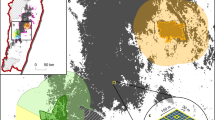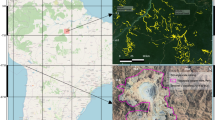Abstract
Growing demand for minerals is increasing pressure to open protected areas (PAs) for mining. Here we develop spatially explicit models to compare impacts among five policy scenarios to downgrade combinations of PA to allow mining in the Brazilian Amazon. We found downgrading (opening) the region’s entire PAs network to develop an additional 242 mineral deposits would cause 183 km2 of deforestation from mining, half of this in highly biodiverse regions. This scenario would also require 1,463 km of new roads that facilitate access to the region, causing indirect deforestation (estimated to be 40 times larger than direct mining clearing) and forest fragmentation. Downgrading fewer PAs would halve the impacts of mine expansion but require longer access roads per additional deposit mined to avoid crossing areas still protected. Promoting sustainable development while safeguarding biodiversity in mineral-rich regions requires strategic long-term planning that includes identifying no-go areas critical to conservation and designing policies to reduce infrastructure impact when providing access to new mining areas.
This is a preview of subscription content, access via your institution
Access options
Access Nature and 54 other Nature Portfolio journals
Get Nature+, our best-value online-access subscription
$29.99 / 30 days
cancel any time
Subscribe to this journal
Receive 12 digital issues and online access to articles
$119.00 per year
only $9.92 per issue
Buy this article
- Purchase on Springer Link
- Instant access to full article PDF
Prices may be subject to local taxes which are calculated during checkout




Similar content being viewed by others
Data availability
All data supporting the findings of this study are either publicly available online via the referenced source or can be obtained directly from the corresponding author upon request.
References
Adams, V. M., Iacona, G. D. & Possingham, H. P. Weighing the benefits of expanding protected areas versus managing existing ones. Nat. Sustain. 2, 404–411 (2019).
Blicharska, M. et al. Biodiversity’s contributions to sustainable development. Nat. Sustain. 2, 1083–1093 (2019).
Hanson, J. O. et al. Global conservation of species’ niches. Nature 580, 232–234 (2020).
Sonter, L. J., Barrett, D. J., Soares-filho, B. S. & Moran, C. J. Global demand for steel drives extensive land-use change in Brazil’ s Iron Quadrangle. Glob. Environ. Change 26, 63–72 (2014).
Siqueira-Gay, J., Soares-Filho, B., Sánchez, L. E., Oviedo, A. & Sonter, L. J. Proposed legislation to mine Brazil’s Indigenous lands will threaten Amazon forests and their valuable ecosystem services. One Earth 3, 356–362 (2020).
El Bizri, H. R., Macedo, J. C. B. M., Plaglia, A. P. & Morcatty, T. Q. Mining undermining Brazil’s environment. Science 353, 2–3 (2016).
Ferreira, J. et al. Brazil’s environmental leadership at risk. Science 346, 706–707 (2014).
Rudke, A. P. et al. Impact of mining activities on areas of environmental protection in the southwest of the Amazon: a GIS- and remote sensing-based assessment. J. Environ. Manage. 263, 110392 (2020).
Naughton-Treves, L. & Holland, M. B. Losing ground in protected areas? Science 364, 832–833 (2019).
Kroner, R. E. G. et al. The uncertain future of protected lands and waters. Science 364, 881–886 (2019).
Pack, S. M. et al. Protected area downgrading, downsizing, and degazettement (PADDD) in the Amazon. Biol. Conserv. 197, 32–39 (2016).
PADDDtracker.org Data Release Version 2.0 (Conservation International and World Wildlife Fund, 2019); https://doi.org/10.5281/zenodo.3371733
Bebbington, A. J., Humphreys, D., Aileen, L., Rogan, J. & Agrawal, S. Resource extraction and infrastructure threaten forest cover and community rights. Proc. Natl Acad. Sci. USA 115, 13164–13173 (2018).
Paiva, P. F. P. R. et al. Deforestation in protect areas in the Amazon: a threat to biodiversity. Biodivers. Conserv. 29, 19–38 (2020).
Boldy, R., Santini, T., Annandale, M., Erskine, P. D. & Sonter, L. J. Understanding the impacts of mining on ecosystem services through a systematic review. Extr. Ind. Soc. https://doi.org/10.1016/j.exis.2020.12.005 (2020).
Murguía, D. I., Bringezu, S. & Schaldach, R. Global direct pressures on biodiversity by large-scale metal mining: spatial distribution and implications for conservation. J. Environ. Manage. 180, 409–420 (2016).
Kobayashi, H., Watando, H. & Kakimoto, M. A global extent site-level analysis of land cover and protected area overlap with mining activities as an indicator of biodiversity pressure. J. Clean. Prod. 84, 459–468 (2014).
Craig, M. D., White, D. A., Stokes, V. L. & Prince, J. Can postmining revegetation create habitat for a threatened mammal? Ecol. Manage. Restor. 18, 149–155 (2017).
Sonter, L. J. et al. Mining drives extensive deforestation in the Brazilian Amazon. Nat. Commun. 8, 1013 (2017).
Siqueira-Gay, J., Sonter, L. J. & Sánchez, L. E. Exploring potential impacts of mining on forest loss and fragmentation within a biodiverse region of Brazil’s northeastern Amazon. Resour. Policy 67, 101662 (2020).
Siqueira-Gay, J. & Sánchez, L. E. Keep the Amazon niobium in the ground. Environ. Sci. Policy 111, 1–6 (2020).
Mascia, M. B. & Pailler, S. Protected area downgrading, downsizing, and degazettement (PADDD) and its conservation implications. Conserv. Lett. 4, 9–20 (2011).
Raiter, K. G., Possingham, H. P., Prober, S. M. & Hobbs, R. J. Under the radar: mitigating enigmatic ecological impacts. Trends Ecol. Evol. 29, 635–644 (2014).
Whitehead, A. L., Kujala, H. & Wintle, B. A. Dealing with cumulative biodiversity impacts in strategic environmental assessment: a new frontier for conservation planning. Conserv. Lett. 10, 195–204 (2017).
Jenner, N. Making Mining ‘Forest-Smart’: Executive Summary Report (World Bank, 2019); http://documents.worldbank.org/curated/en/369711560319906622/Making-Mining-Forest-Smart-Executive-Summary-Report
Renca: Situação legal dos direitos minerários da reserva nacional do cobre (WWF, 2017).
Soares-Filho, B. S., Cerqueira, G. C. & Pennachin, C. L. DINAMICA—a stochastic cellular automata model designed to simulate the landscape dynamics in an Amazonian colonization frontier. Ecol. Modell. 154, 217–235 (2002).
Strand, J. et al. Spatially explicit valuation of the Brazilian Amazon forest’s ecosystem services. Nat. Sustain. 1, 657–664 (2018).
Barber, C. P., Cochrane, M. A., Souza, C. M. & Laurance, W. F. Roads, deforestation, and the mitigating effect of protected areas in the Amazon. Biol. Conserv. 177, 203–209 (2014).
Rorato, A. C. et al. Brazilian Amazon Indigenous peoples threatened by mining bill. Environ. Res. Lett. 15, 1040a3 (2020).
Villén-Pérez, S., Anaya-Valenzuela, L., Conrado da Cruz, D. & Fearnside, P. M. Mining threatens isolated Indigenous peoples in the Brazilian Amazon. Glob. Environ. Change 72, (2022).
Siqueira-Gay, J. & Sánchez, L. E. The outbreak of illegal gold mining in the Brazilian Amazon boosts deforestation. Reg. Environ. Change 21, 28 (2021).
Sonter, L. J., Dade, M. C., Watson, J. E. M. & Valenta, R. K. Renewable energy production will exacerbate mining threats to biodiversity. Nat. Commun. 11, 4174 (2020).
Tallis, H., Kennedy, C. M., Ruckelshaus, M., Goldstein, J. & Kiesecker, J. M. Mitigation for one & all: an integrated framework for mitigation of development impacts on biodiversity and ecosystem services. Environ. Impact Assess. Rev. 55, 21–34 (2015).
Bull, J. W. et al. Quantifying the “avoided” biodiversity impacts associated with economic development. Front. Ecol. Environ. https://doi.org/10.1002/fee.2496 (2022).
Gastauer, M. et al. Mine land rehabilitation: modern ecological approaches for more sustainable mining. J. Clean. Prod. 172, 1409–1422 (2018).
Souza, B. A., Rosa, J. C. S., Siqueira-Gay, J. & Sánchez, L. E. Mitigating impacts on ecosystem services requires more than biodiversity offsets. Land Use Policy 105, 105393 (2021).
Ritter, C. D. et al. Environmental impact assessment in Brazilian Amazonia: challenges and prospects to assess biodiversity. Biol. Conserv. 206, 161–168 (2017).
Good Practice Handbook: Cumulative Impact Assessment and Management, Guidance for the Private Sector in Emerging Markets (IFC, 2013).
Gunn, J. H. & Noble, B. F. Integrating cumulative effects in regional strategic environmental assessment frameworks: lessons from practice. J. Environ. Assess. Policy Manage. 11, 267–290 (2009).
Ferrante, L. & Fearnside, P. M. The Amazon’ s road to deforestation. Science 20, 20–22 (2020).
Runge, C. A., Tulloch, A. I. T., Gordon, A. & Rhodes, J. R. Quantifying the conservation gains from shared access to linear infrastructure. Conserv. Biol. 31, 1428–1438 (2017).
Kiesecker, J. M., Copeland, H., Pocewicz, A. & McKenney, B. Development by design: blending landscape-level planning with the mitigation hierarchy. Front. Ecol. Environ. 8, 261–266 (2010).
Heiner, M. et al. Moving from reactive to proactive development planning to conserve Indigenous community and biodiversity values. Environ. Impact Assess. Rev. 74, 1–13 (2019).
Pfaff, A., Robalino, J., Herrera, D. & Sandoval, C. Protected areas’ impacts on Brazilian Amazon deforestation: examining conservation–development interactions to inform planning. PLoS ONE 10, 1–17 (2015).
Almeida, C. A. et al. High spatial resolution land use and land cover mapping of the Brazilian Legal Amazon in 2008 using Landsat-5 / TM and MODIS data. Acta Amazon. 46, 291–302 (2008).
Asner, G. P. & Tupayachi, R. Accelerated losses of protected forests from gold mining in the Peruvian Amazon. Environ. Res. Lett. 12, 094004 (2016).
Boham-Carter, G. F. Geographic Information Systems for Geoscientists: Modelling with GIS (Elsevier, 1994).
Soares-Filho, B., Rodrigues, H. & Follador, M. A hybrid analytical–heuristic method for calibrating land-use change models. Environ. Model. Softw. 43, 80–87 (2013).
INPE. TerraClass https://www.terraclass.gov.br/geoportal-aml/ (2021).
INPE. Slope http://www.dsr.inpe.br/topodata/acesso.php (2020).
Ministério do Meio Ambiente (MMA). Conservation units http://mapas.mma.gov.br/i3geo/datadownload.htm (2022).
Fundação Nacional do Índio (FUNAI). Indigenous lands http://www.funai.gov.br/index.php/shape (2021).
Leite-Filho, A., Soares-filho, B. S., Davis, J. & Rodrigues, H. Dinamica EGO Guidebook (Centro de Sensoriamento Remoto, UFMG, 2020).
Serviço Geológico do Brasil. Mineral deposits https://geosgb.cprm.gov.br/ (2020).
Soares-Filho, B. et al. Simulating the response of land-cover changes to road paving and governance along a major Amazon highway: the Santarém-Cuiabá corridor. Glob. Change Biol. 10, 745–764 (2004).
Centro de Sensoriamento Remoto. Biodiversity https://csr.ufmg.br/amazones/biodiversity/ (2021).
Fahrig, L. Ecological responses to habitat fragmentation per se. Annu. Rev. Ecol. Evol. Syst. 48, 1–23 (2017).
Pardini, R., de Bueno, A. A., Gardner, T. A., Prado, P. I. & Metzger, J. P. Beyond the fragmentation threshold hypothesis: regime shifts in biodiversity across fragmented landscapes. PLoS ONE 5, e13666 (2010).
Montibeller, B., Kmoch, A., Virro, H., Mander, Ü. & Uuemaa, E. Increasing fragmentation of forest cover in Brazil’s Legal Amazon from 2001 to 2017. Sci. Rep. 10, 5803 (2020).
Cabral, A. I. R., Saito, C., Pereira, H. & Laques, A. E. Deforestation pattern dynamics in protected areas of the Brazilian Legal Amazon using remote sensing data. Appl. Geogr. 100, 101–115 (2018).
Colson, F., Bogaert, J. & Ceulemans, R. Fragmentation in the Legal Amazon, Brazil: can landscape metrics indicate agricultural policy differences? Ecol. Indic. 11, 1467–1471 (2011).
Monmonier, M. S. Measures of pattern complexity for choroplethic maps. Am. Cartogr. 1, 159–169 (1974).
Werner, T. T. et al. Global-scale remote sensing of mine areas and analysis of factors explaining their extent. Glob. Environ. Change 60, 102007 (2020).
Soares-Filho, B. et al. Roads, http://maps.csr.ufmg.br/ (2016).
Acknowledgements
This study was financed in part by the Coordenação de Aperfeiçoamento de Pessoal de Nível Superior—Brasil (CAPES)—Finance Code 001. This research was supported by the São Paulo Research Foundation (grant 2018/12475-7). J.P.M. was funded by the National Council for Scientific and Technological Development (CNPQ, 309767/2021-0).
Author information
Authors and Affiliations
Contributions
J.S.-G., L.J.S. and L.E.S. were involved in the conceptualization. J.S.-G. wrote the original draft, and J.P.M., L.J.S. and L.E.S. reviewed and discussed all results. J.S.-G. processed data and designed maps. L.J.S. supervised the modelling exercise, and J.P.M. supervised the fragmentation analysis.
Corresponding author
Ethics declarations
Competing interests
The authors declare no competing interests.
Peer review
Peer review information
Nature Sustainability thanks Tim Werner and the other, anonymous, reviewer(s) for their contribution to the peer review of this work.
Additional information
Publisher’s note Springer Nature remains neutral with regard to jurisdictional claims in published maps and institutional affiliations.
Supplementary information
Supplementary Information
Supplementary Figs. 1–17 and Tables 1–16.
Rights and permissions
About this article
Cite this article
Siqueira-Gay, J., Metzger, J.P., Sánchez, L.E. et al. Strategic planning to mitigate mining impacts on protected areas in the Brazilian Amazon. Nat Sustain 5, 853–860 (2022). https://doi.org/10.1038/s41893-022-00921-9
Received:
Accepted:
Published:
Issue Date:
DOI: https://doi.org/10.1038/s41893-022-00921-9
This article is cited by
-
Mercury and CO2 emissions from artisanal gold mining in Brazilian Amazon rainforest
Nature Sustainability (2023)
-
Amazon deforestation: simulated impact of Brazil’s proposed BR-319 highway project
Environmental Monitoring and Assessment (2023)
-
Brazilian Amazon indigenous territories under deforestation pressure
Scientific Reports (2023)
-
Record-breaking fires in the Brazilian Amazon associated with uncontrolled deforestation
Nature Ecology & Evolution (2022)



